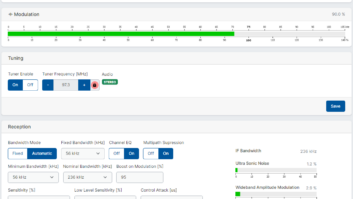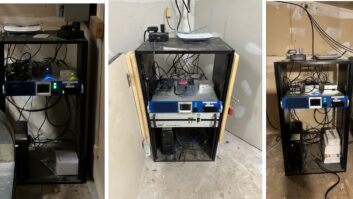Pulse Width Modulation (PWM) or Pulse Duration Modulation (PDM) is a technique of converting analog signals into rectangular waveforms. The width of the waveform varies in proportion with the amplitude of the analog signal.
PWM solid-state AM transmitters are widely used today thanks to their efficiency, redundancy and reliability. Manufacturers have gone through a number of iterations since the first solid-state transmitters were introduced back in the 1970s. Much has changed, but the basic PWM technique is still in use today. Unfortunately, a number of manufacturers have closed down, and technical assistance for their equipment has become difficult or nonexistent. Thus, in many cases, it is up to the service engineers to figure things out in the field. I say this because this is exactly my experience with some of the stations I serviced.
TUBE AM CIRCUIT

For many years, AM transmitters used vacuum tubes for the power amplifiers and for the driver circuit. A simplified AM transmitter circuit is shown in Fig. 1. The DC high voltage connects to the PA tube through the modulation transformer.
Let us assume first that there is no audio signal. With the high voltage on the plate, the RF carrier signal from the driver stage is amplified by the PA tube. However, only a portion of the positive half of the sine wave (a pulse) is amplified because the PA tube is biased class C, which conducts at less than 180 electrical degrees. Therefore, a tank circuit is needed to recover the negative half of the pulse to complete the whole waveform. At this point, the RF carrier amplitude is constant.
With the presence of an audio signal, the low-level audio will be amplified by the push-pull modulator tubes to produce the high-level audio at the output of the modulation transformer. Because the modulation transformer is inserted between the HV supply and the tube plate, the amplitude of the RF carrier will vary with the audio signal, completing the amplitude modulation.
SOLID-STATE AM CIRCUIT
In the tube circuit, the amplifiers operate class B for the modulator and class C for the RF carrier. On the other hand, the solid-state transmitter operates in class D for both the modulator and the RF carrier amplifier (some manufacturers use class E for RF). In other words, the transistors are either on or off. Thus, the amplification becomes more efficient compared to the already highly efficient class C.
The drive signal for the RF carrier amplifier is a square wave, while the drive signal for the modulator is a rectangular wave with the width varying in accordance with the PWM duty cycle.
The Metal-Oxide-Semiconductor Field-Effect Transistor (MOSFET) is the most widely used transistor for both the PA and modulator because unlike the Bipolar Junction transistor (BJT), it is voltage-driven and has very low switching loss.

A simplified diagram of a solid-state amplifier is shown in Fig. 2. As we saw with the tube transmitter, the modulator section consists of the tubes and the modulation transformer. These parts were replaced by the PWM amplifier and filter in the solid-state circuit.
On the RF side, an “H-bridge” amplifier is used. Two other things can be noticed on the RF side: the absence of the tank circuit, and the output of the H-bridge goes out to a combiner instead of going out to the antenna.
To analyze the action of this circuit, let us assume first that there is no PWM amplifier and filter circuit. Second, the RF amplifier is directly connected to the DC power supply. At the positive half cycle of the drive signal, transistors 1 and 3 turn on, forming the positive half of the waveform at the output of the transformer. The other two transistors remain off at this point.
On the negative half of the cycle, transistors 4 and 2 turn on, forming the negative half of the waveform at the output of the transformer. These two halves complete the full RF waveform. Because of the full waveform, a tank circuit is not needed.

To achieve AM modulation, the PWM amplifier and filter must produce the proper high-level audio signal.

Looking at Figs. 2 and 4, the PWM driver converts the low-level audio to pulses with varying widths. The conversion is easily accomplished with a comparator IC having the audio signal and a triangle wave as inputs. The output of the comparator op-amp is connected to a driver IC which has a high input/output isolation level.
The power supply of this IC needs to be isolated as well so that the PWM transistors can properly operate as a series modulator. The PWM amplifier transistors switch on and off in accordance with the signal from the driver IC, and thus converting the low level PWM to a high level PWM.
There are usually two or more transistors in parallel to handle the required power. A low-pass filter is used in order to recover the modulated waveform from the rectangular wave output of the PWM amplifier. The recovered audio waveform modulates the RF carrier, thus completing the amplitude modulated signal.
In an actual transmitter, this combination of PWM and H-bridge RF amplifier is usually on one board (or card), and a number of these boards are combined within a power module, depending on the power output needed. Solid-state transmitters have multiple numbers of power modules. The output signals of all the modules are combined in a main combiner.
The combiner can be series or parallel, as shown in Fig. 3. The parallel combiner has very low impedance at the combining point (much like the equivalent resistance of parallel resistors), while the series combiner has a high impedance at the output (much like connecting series of resistors). Although we have the AM signal from the combiner, the RF carrier is still in square waves. A network of LC harmonic filters (band-pass, low-pass or a combination of both) is used to filter the harmonics out of the square waves and also to match the combiner to the transmission line impedance.
PUTTING THEORY TO WORK
In a classroom, the students know that after learning the theory on a subject, work on actual circuits will come next. Likewise, knowing all the theory of PWM must be complemented by working on actual circuits. For this objective, I built an actual PWM low-power AM transmitter.

The details of the actual work and the circuit itself are so many that a detailed discussion is beyond the scope of this article. However, a sample circuit diagram and some waveform pictures are shown in Figs. 5–8. For this project, studying the following topics was helpful:

1. Principles of AM modulation. Understanding the theory behind AM is a good foundation for this project.
2. FET switching circuits and square wave RF oscillators. Half-bridge and full-bridge circuits are often used in switching FET circuits. One critical part is the driver IC. There are plenty of driver IC circuits in audio and RF available from the market. Fig. 5 shows a driver circuit.

3. RF transformers. AM transmitter power modules have plenty of wire-wound ferrite-core transformers on the board. For this project, these filters and transformers were hand-wound properly in order to work.

4. Principles of PWM circuits. An essential part of making a PWM circuit is the setting up of the audio and triangle wave signal such that a proper PWM waveform is produced at the output of the comparator. A precise triangle waveform is also needed.
5. Filter and matching networks. Filters are used in both the modulator and RF. Impedance matching is essential between amplifier stages.
The solid-state AM transmitter today has become more sophisticated, and the station engineer should keep pace with the latest trends. Understanding PWM and switching amplifiers is indeed necessary for this task, and making a working circuit will help in the learning process. Staying ahead will surely benefit the engineer in the long run.
John Marcon, CBTE CBRE, recently worked as acting chief engineer of Victory Television Network (VTN) in Little Rock, Ark. He has 27 years’ experience with radio and TV broadcast transmitters and other equipment, and is a former vocational electronics teacher. He is an SBE-certified radio and television broadcast engineer who holds a bachelor’s degree in electronics and communications engineering.







